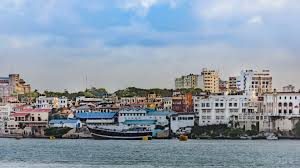Mombasa’s Old Town is a historic and culturally rich area located in the heart of Mombasa, Kenya. It’s a labyrinthine network of narrow streets, alleys, and buildings that bear witness to centuries of trade, cultural exchange, and historical events. Here’s a deeper understanding of Mombasa’s Old Town:
Historical Significance:
Mombasa’s Old Town is one of the oldest settlements along the East African coast. Its history dates back to the 12th century when Swahili city-states flourished along the coast, engaging in trade with merchants from Arabia, Persia, India, and beyond.
Architectural Heritage:
The architecture of Old Town is a fascinating blend of Arab, Persian, Indian, and European influences. The narrow streets are lined with intricately carved wooden doors, coral stone buildings, and ornate balconies, all showcasing the diverse cultural history of the region.
Cultural Diversity:
Throughout its history, Old Town has been a melting pot of cultures, languages, and traditions. Swahili culture serves as a central theme, with influences from Arab and Indian traders evident in the architecture, cuisine, and way of life.
Maze-Like Layout:
The layout of Old Town is deliberate, featuring narrow and winding streets. This layout was developed as a defense mechanism against potential attacks from the sea and reflects the historical need for protection against pirates and invaders.
Cultural Landmarks:
Old Town is home to various cultural landmarks, including mosques, temples, and churches. These places of worship showcase the religious diversity of the community, with structures like the Mandhry Mosque, the Shri Swaminarayan Temple, and the Old Digo Road Mosque.
Local Markets:
The Old Town area is dotted with markets where you can experience the local way of life. These markets offer a wide range of goods, including spices, fruits, vegetables, clothing, and crafts. The markets are vibrant hubs of activity and a great place to interact with locals.
Conservation Efforts:
Mombasa’s Old Town has faced challenges such as decay, inadequate infrastructure, and the pressures of modernization. However, there have been efforts to preserve its historical and cultural heritage. The area has been recognized as a UNESCO World Heritage Site to protect its unique character.
Cultural Events:
Throughout the year, Old Town hosts various cultural events, festivals, and celebrations that highlight its heritage. These events often involve traditional music, dance, food, and crafts.
Tourism and Exploration:
Old Town is a popular destination for tourists interested in history, culture, and architecture. Guided tours are available to help visitors navigate the area and learn about its significance.
When visiting Mombasa’s Old Town, it’s recommended to explore with a guide who can provide context and insights into the area’s history. This way, you can fully appreciate the intricate details, stories, and cultural significance that make Old Town a captivating and unique part of Mombasa’s identity. For more details about tour guide contact Ghalib Zahran on 0714210985


